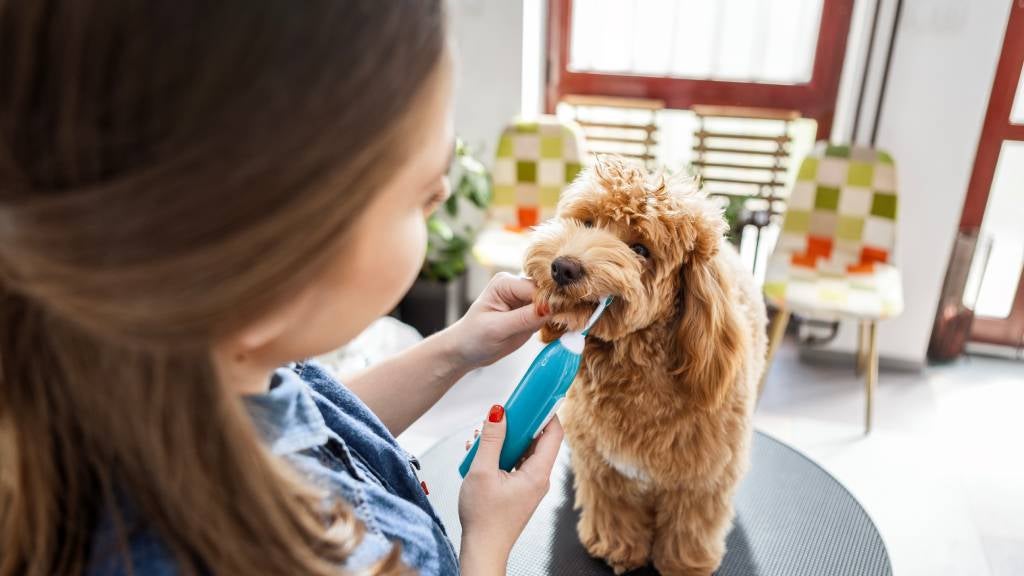Quick take
- Around 80% of Aussie dogs show signs of dental disease by age three according to the Australian Veterinary Association
- Brushing and chews help prevent plaque, bad breath, and gum disease
- Human toothpaste is toxic for dogs – always use pet-safe options
- Professional vet dental cleaning may be needed for gumline care
- Consistent oral hygiene helps your pup live a healthier, happier life
Why your dog’s dental health matters
When we think of keeping our dogs healthy, we often picture exercise, good food, or regular vet visits. But there’s one area that often gets overlooked – dental health.
Dogs can suffer from plaque, tartar build-up, gum disease, and tooth decay. In fact, the Australian Veterinary Association (AVA) notes that around 80% of dogs show signs of dental disease by the age of three. Left untreated, poor oral hygiene can lead to pain, tooth loss, and even infections that affect the heart, liver, or kidneys, as stated by AVA. This is something no pet parent wants for their four-legged friend.
The good news? With a little prevention at home, you can keep your buddy’s pearly whites healthy and avoid costly trips to the vet. Keeping up with your dog’s oral hygiene is just as important as exercise or diet.
Related: What foods are dangerous for your dog?
Signs your dog may have dental problems
Watch for these common warning signs:
- Persistent bad breath
- Yellow or brown plaque build-up on teeth
- Red or swollen gums
- Difficulty eating or dropping food
- Excessive drooling
- Pawing at the mouth
If you notice any of these, it’s worth booking a vet check-up. Untreated dental issues can cause serious health complications over time.
See how learning how to interpret body language in dogs can help you work out if your pet is in dental pain with our complete guide.
How to clean your dog’s teeth at home
1. Start brushing – gently
Brushing is the gold standard for dog dental care. Use a dog-specific toothbrush (finger brushes are great for beginners) and a pet-safe toothpaste (never use human toothpaste, as fluoride can be toxic to dogs).
- Begin slowly – let your dog lick the toothpaste first
- Gently lift their lip and brush in small circles
- Aim for a few teeth at a time and gradually build up
Tip: Consistency is key. Even brushing 2–3 times a week can make a big difference.
Related: What foods are dangerous for your dog?
2. Choose dental chews and toys
Dental chews can help reduce plaque and freshen breath. Certain toys – like rubber chew toys or rope toys – also encourage chewing, which naturally helps scrape teeth clean.
Related: Are bones good for my dog?
3. Feed a dental-friendly diet
Some pet foods are specially designed to improve dental health. These kibble pieces are often larger and textured to help clean teeth as dogs chew.
Adding raw bones like chicken necks (from your local butcher, never cooked) can also help – but always check with your vet first to avoid choking hazards or tooth fractures, depending on the size and age of your dog and other health conditions.
4. Regular vet check-ups and professional cleaning
Even with great home care, most dogs will need a professional dental clean at some stage. Vets can remove plaque below the gumline where brushing can’t reach.
Annual check-ups also give your vet the chance to spot early signs of gum disease before it becomes serious.
Easy tips to make dental care part of your routine
- Start young: Puppies adapt quickly to brushing
- Make it positive: Reward with treats, pats, or play after brushing
- Set reminders: Add dental care to your weekly routine
- Mix it up: Alternate between brushing, chews, and dental diets
Busting myths about dog dental health
“Dogs don’t need their teeth brushed” → False. Chewing helps, but it doesn’t replace brushing.
“Dry food alone keeps teeth clean” → Not enough. While kibble may reduce plaque compared to soft food, it doesn’t prevent gum disease.
“Bad breath is normal in dogs” → Not true. Persistent bad breath often signals dental problems and may need treatment.
Final thoughts
Keeping your dog’s teeth clean doesn’t have to be stressful – or expensive. Buddy Pet Insurance offers the optional extra of Booster Care that can cover specified dental conditions.
With a mix of brushing, chews, the right diet, and regular vet care, you’ll help your dog stay happy, healthy, and chomping on treats and chew toys for years to come.
FAQsFrequently Asked Questions about dog dental care
Sink your teeth into answers to some common questions pet lovers ask about maintaining their dog’s dental health.
Can I use human toothpaste on my dog?
No – human toothpaste contains fluoride, which is toxic to dogs. Always use pet-safe toothpaste.
How often should I brush my dog’s teeth?
Ideally daily, but even 2–3 times a week helps reduce plaque and bad breath.
What is periodontal disease in dogs?
It’s advanced gum disease caused by plaque and tartar build-up. It can lead to tooth loss and infections if untreated.
Do all dogs need professional vet dental cleaning?
Most will at some stage, especially as they age. Vets can clean below the gumline, where home care can’t reach.
7 Nov 2025

